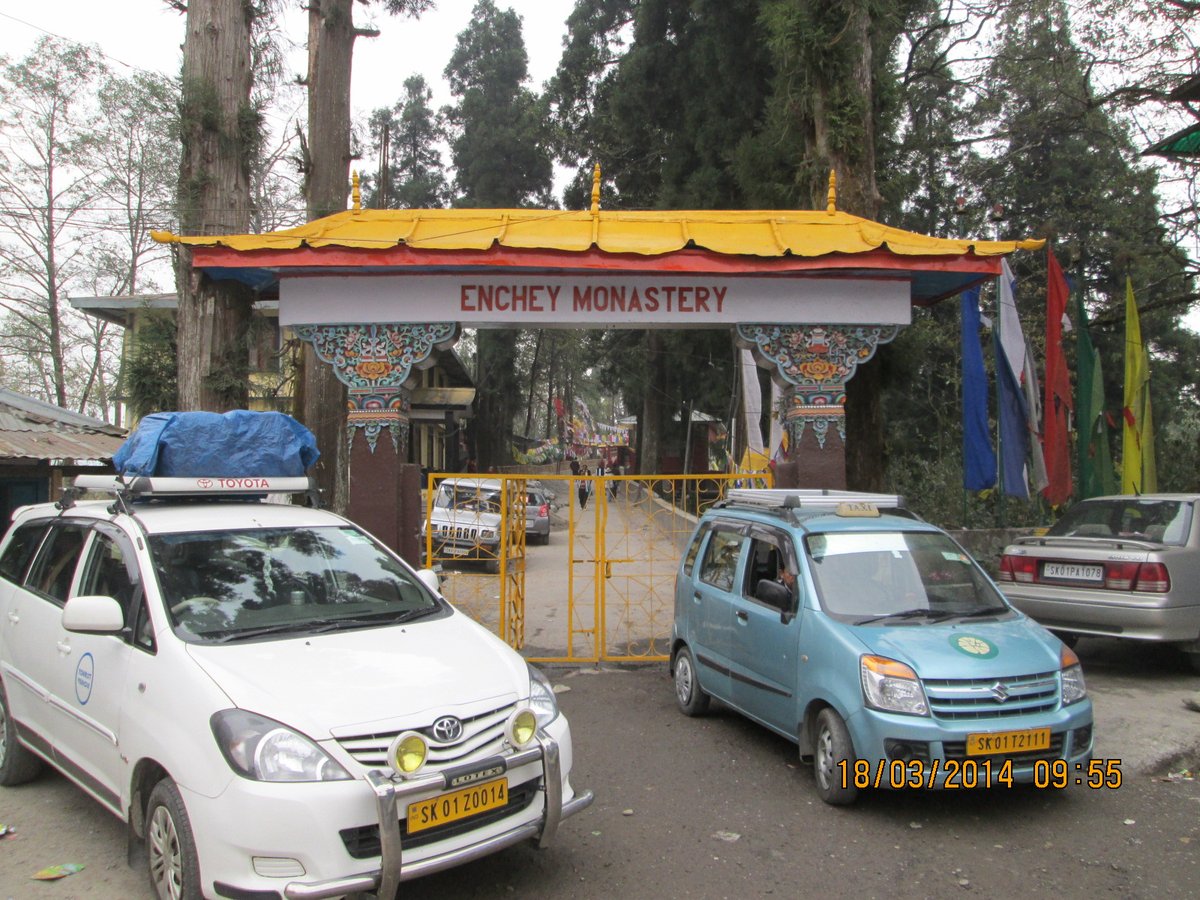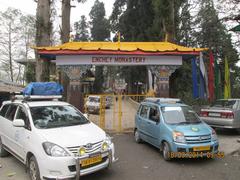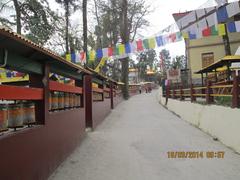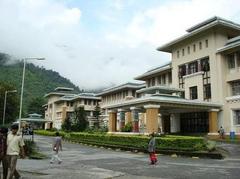
Visiting Hours, Tickets, and Historical Insights of Enchey Monastery, Gangtok
Date: 19/07/2024
Discover the Enchey Monastery: A Brief Introduction
Enchey Monastery, perched on a hill in Gangtok, Sikkim, India, is a spiritual haven and a cultural landmark that dates back to 1909. Established by Lama Drupthob Karpo, a revered tantric master known for his flying powers, the monastery holds immense religious significance for the local Buddhist community (Sikkim Tourism). The term ‘Enchey’ translates to ‘the solitary temple,’ reflecting its initial isolated location amidst dense forests. The monastery’s architectural design is a testament to traditional Tibetan Buddhist style, adorned with vibrant murals, intricate wood carvings, and colorful prayer flags that create a serene and spiritual ambiance (Cultural India). As a center for religious learning and meditation, Enchey Monastery follows the Nyingma tradition of Vajrayana Buddhism, attracting monks and devotees from across the region (Buddhist Tourism).
The monastery is also renowned for its vibrant festivals such as the Cham dance and Pang Lhabsol, which are major attractions for both locals and tourists. These festivals offer a visual spectacle with elaborate costumes and masks representing various deities and mythical creatures (Sikkim Tourism). The cultural impact of Enchey Monastery extends beyond its religious significance, serving as a repository of ancient manuscripts, religious texts, and artifacts, thereby preserving and promoting the rich heritage of Sikkim (Cultural India). For visitors, the monastery offers a tranquil and spiritual atmosphere, with guided tours providing insights into its history, architecture, and religious significance. Accessibility features ensure that differently-abled visitors can also enjoy the experience, making it a must-visit destination for those exploring Gangtok.
Table of Contents
- Origins and Establishment
- Architectural Significance
- Religious Importance
- Festivals and Rituals
- Cultural Impact
- Visitor Information
- Top Nearby Attractions to Visit When Exploring Enchey Monastery
Enchey Monastery - Visiting Hours, Tickets, History & Travel Tips in Gangtok
Origins and Establishment
Enchey Monastery, located in Gangtok, Sikkim, India, is a significant religious site with a rich history dating back to the early 20th century. The monastery was established in 1909 by Lama Drupthob Karpo, a revered tantric master known for his flying powers. The site was believed to be blessed by the presence of Khangchendzonga, the guardian deity of Sikkim, and Yabdean, the protector of the region. The name “Enchey” translates to “the solitary temple,” reflecting its initial isolated location amidst dense forests (Sikkim Tourism).
Architectural Significance
The architectural design of Enchey Monastery is a testament to traditional Tibetan Buddhist style. The monastery is adorned with vibrant murals, intricate wood carvings, and colorful prayer flags that flutter in the wind, creating a serene and spiritual ambiance. The main prayer hall houses statues of Buddha, Loki Sharia, and Guru Padmasambhava, which are central to the religious practices conducted here. The monastery’s structure has undergone several renovations, with significant contributions from the Chogyal rulers of Sikkim, who were instrumental in its preservation and expansion (Cultural India).
Religious Importance
Enchey Monastery holds immense religious significance for the local Buddhist community. It follows the Nyingma tradition of Vajrayana Buddhism, one of the oldest schools of Tibetan Buddhism. The monastery is a center for religious learning and meditation, attracting monks and devotees from across the region. It is believed that the monastery’s location is blessed with the protective presence of deities, making it a powerful site for spiritual practices and rituals (Buddhist Tourism).
Festivals and Rituals
The monastery is renowned for its vibrant festivals, which are a major attraction for both locals and tourists. The most significant festival celebrated here is the Cham dance, held annually in January. This masked dance, performed by monks, depicts the victory of good over evil and is accompanied by traditional music and chants. The festival is a visual spectacle, with elaborate costumes and masks representing various deities and mythical creatures. Another important festival is Pang Lhabsol, celebrated in August, which honors the guardian deity Khangchendzonga and seeks his blessings for the well-being of the region (Sikkim Tourism).
Cultural Impact
Enchey Monastery is not just a religious site but also a cultural hub that plays a vital role in preserving and promoting the rich heritage of Sikkim. The monastery’s festivals, rituals, and daily practices offer a glimpse into the traditional lifestyle and beliefs of the local Buddhist community. It serves as a repository of ancient manuscripts, religious texts, and artifacts, contributing to the cultural and historical knowledge of the region. The monastery also engages in various social and educational activities, supporting the local community and fostering a sense of unity and spiritual growth (Cultural India).
Visitor Information
Visiting Hours and Tickets
Enchey Monastery is open daily from 9:00 AM to 6:00 PM. There is no entry fee, making it accessible for everyone. However, donations are welcomed and go towards the maintenance and activities of the monastery. Special guidelines for visitors include maintaining silence, dressing modestly, and seeking permission before taking photographs inside the prayer hall.
Travel Tips and Nearby Attractions
Gangtok offers several other attractions near Enchey Monastery that visitors can explore. Some nearby sites include Ganesh Tok, Hanuman Tok, and the Flower Exhibition Centre. For those interested in local cuisine, several eateries in Gangtok offer traditional Sikkimese dishes.
Accessibility
Enchey Monastery is accessible to differently-abled visitors. The monastery has ramps and pathways designed to accommodate wheelchairs, ensuring that everyone can enjoy the spiritual and cultural experience it offers.
Preservation Efforts
Efforts to preserve and maintain Enchey Monastery are ongoing, with support from both the government and private organizations. The monastery is recognized as a heritage site, and various initiatives are in place to ensure its structural integrity and cultural significance are preserved for future generations. Restoration projects focus on maintaining the original architectural style while incorporating modern techniques to enhance durability. Community involvement is also encouraged, with locals participating in the upkeep and promotion of the monastery (Sikkim Tourism).
Top Nearby Attractions to Visit When Exploring Enchey Monastery in Gangtok
Tashi Viewpoint
Tashi Viewpoint is a popular tourist spot located approximately 8 kilometers from Gangtok. It offers a panoramic view of the majestic Kanchenjunga mountain range and the surrounding valleys. The viewpoint is named after Tashi Namgyal, the King of Sikkim, who ruled from 1914 to 1963. Visitors can enjoy the breathtaking sunrise and sunset views, making it a perfect spot for photography enthusiasts. The viewpoint is equipped with a small cafeteria and a souvenir shop, providing a comfortable experience for tourists (source).
Visiting Hours: Open all day
Tickets: Free entry
Ganesh Tok
Ganesh Tok is a small temple dedicated to Lord Ganesha, located about 7 kilometers from Gangtok. Situated at an altitude of 6,500 feet, the temple offers a stunning view of Gangtok town, the Raj Bhavan complex, and the surrounding hills. The temple is known for its serene ambiance and is a popular spot for both tourists and locals. The observation deck near the temple provides a 360-degree view of the landscape, making it a must-visit attraction (source).
Visiting Hours: 6:00 AM - 7:00 PM
Tickets: Free entry
Hanuman Tok
Hanuman Tok is another significant temple located around 11 kilometers from Gangtok. Dedicated to Lord Hanuman, the temple is maintained by the Indian Army. It is situated at an altitude of 7,200 feet and offers a tranquil environment with spectacular views of the Kanchenjunga range. The temple complex includes a meditation hall and a small garden, making it a peaceful retreat for visitors (source).
Visiting Hours: 7:00 AM - 5:00 PM
Tickets: Free entry
Flower Exhibition Centre
The Flower Exhibition Centre, located near the White Memorial Hall in Gangtok, is a paradise for nature lovers. The center showcases a wide variety of flowers, including rare orchids, seasonal flowers, and ornamental plants. The exhibition is held throughout the year, with the best time to visit being during the annual flower show in April and May. The center also features a small pond and a greenhouse, adding to its charm (source).
Visiting Hours: 9:00 AM - 5:00 PM
Tickets: Entry Fee Applicable
Banjhakri Falls and Energy Park
Banjhakri Falls and Energy Park is a popular recreational spot located about 10 kilometers from Gangtok. The park is spread over 2 acres and features a 100-foot waterfall, ethnic sculptures, and traditional Sikkimese architecture. The park is dedicated to the Banjhakri, a mythical shamanic healer in Sikkimese folklore. Visitors can enjoy a leisurely walk through the park, explore the various attractions, and relax by the waterfall (source).
Visiting Hours: 8:00 AM - 6:00 PM
Tickets: Entry Fee Applicable
Rumtek Monastery
Rumtek Monastery, also known as the Dharma Chakra Centre, is one of the most significant monasteries in Sikkim. Located about 24 kilometers from Gangtok, the monastery is the seat of the Karmapa, the head of the Karma Kagyu lineage of Tibetan Buddhism. The monastery complex includes a main temple, a golden stupa, and several other buildings. Visitors can witness the daily rituals and ceremonies, explore the monastery’s rich history, and enjoy the serene surroundings (source).
Visiting Hours: 6:00 AM - 6:00 PM
Tickets: Entry Fee Applicable
Namgyal Institute of Tibetology
The Namgyal Institute of Tibetology is a renowned research center and museum dedicated to Tibetan culture and history. Located in Deorali, about 2 kilometers from Gangtok, the institute houses a vast collection of Tibetan artifacts, manuscripts, and religious objects. The museum’s exhibits include rare thangkas, statues, and ritual objects, providing a deep insight into Tibetan Buddhism. The institute also has a library with an extensive collection of books and manuscripts on Tibetan studies (source).
Visiting Hours: 9:00 AM - 5:00 PM
Tickets: Entry Fee Applicable
Do Drul Chorten
Do Drul Chorten is one of the most important stupas in Sikkim, located near the Namgyal Institute of Tibetology. Built in 1945 by Trulshik Rinpoche, the stupa is surrounded by 108 prayer wheels, which are inscribed with Buddhist mantras. The stupa complex includes a meditation hall and several smaller stupas, making it a significant religious site for Buddhists. Visitors can participate in the prayer rituals and enjoy the peaceful ambiance of the stupa (source).
Visiting Hours: 8:00 AM - 6:00 PM
Tickets: Free entry
MG Marg
MG Marg, or Mahatma Gandhi Road, is the main shopping and entertainment hub in Gangtok. The pedestrian-only street is lined with shops, restaurants, and cafes, offering a vibrant atmosphere for tourists. Visitors can shop for local handicrafts, souvenirs, and traditional Sikkimese products. The street also hosts various cultural events and festivals, providing a glimpse into the local culture and lifestyle (source).
Visiting Hours: Open all day
Tickets: Free entry
Tsomgo Lake
Tsomgo Lake, also known as Changu Lake, is a glacial lake located about 40 kilometers from Gangtok. Situated at an altitude of 12,400 feet, the lake is surrounded by snow-capped mountains and lush green forests. The lake is considered sacred by the local people and is a popular destination for tourists. Visitors can enjoy a yak ride around the lake, explore the nearby Baba Mandir, and experience the stunning natural beauty of the area (source).
Visiting Hours: Open all day
Tickets: Entry Fee Applicable
Nathula Pass
Nathula Pass is a mountain pass in the Himalayas, located about 54 kilometers from Gangtok. It connects Sikkim with China’s Tibet Autonomous Region and is one of the highest motorable roads in the world. The pass is open to Indian tourists on specific days, and visitors need a special permit to visit. The journey to Nathula Pass offers breathtaking views of the mountains and valleys, making it a memorable experience for adventure enthusiasts (source).
Visiting Hours: Open all day
Tickets: Permit required
Conclusion: Key Takeaways from Your Visit to Enchey Monastery
Enchey Monastery stands as a beacon of spiritual and cultural heritage in Sikkim. Its historical significance, architectural beauty, and religious importance make it a must-visit destination for those exploring the region (Cultural India). The monastery’s festivals and rituals offer a unique insight into the local Buddhist traditions, while its serene environment provides a perfect retreat for meditation and spiritual growth. Preservation efforts ensure that this sacred site continues to inspire and attract visitors from around the world, maintaining its legacy for generations to come. Nearby attractions such as Tashi Viewpoint, Ganesh Tok, and Rumtek Monastery further enrich the visitor experience, offering diverse cultural and natural wonders to explore (Sikkim Tourism). Whether you’re seeking spiritual solace, cultural immersion, or simply a tranquil escape, Enchey Monastery and its surroundings provide a fulfilling and memorable experience for all visitors.
References
- Sikkim Tourism. Enchey Monastery - Visiting Hours, Tickets, History & Travel Tips in Gangtok. https://www.sikkimtourism.gov.in
- Cultural India. Enchey Monastery - Visiting Hours, Tickets, History & Travel Tips in Gangtok. https://www.culturalindia.net
- Buddhist Tourism. Enchey Monastery - Visiting Hours, Tickets, History & Travel Tips in Gangtok. https://www.buddhist-tourism.com




